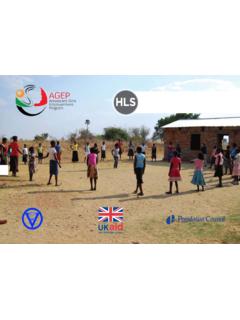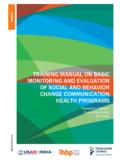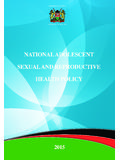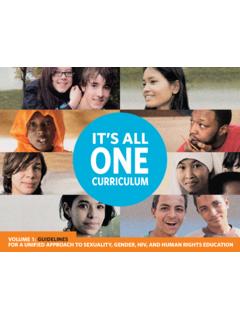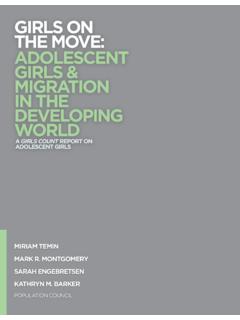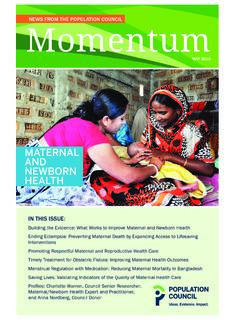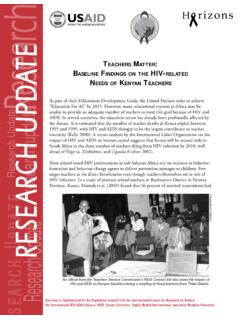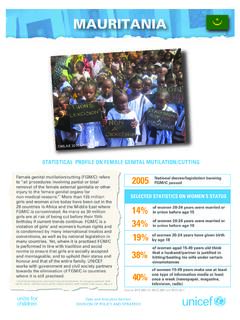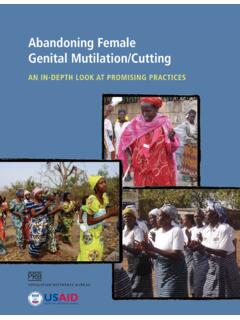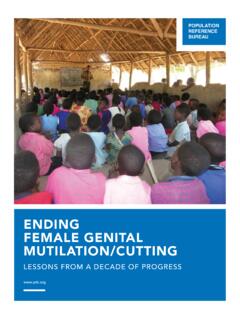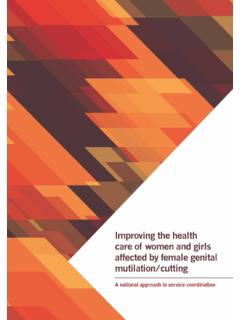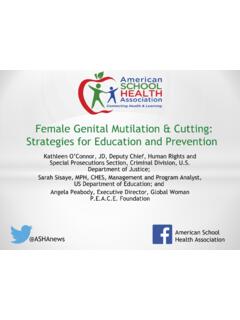Transcription of Ending the medicalization of female genital mutilation ...
1 Policy brief Ending The medicalization Of female genital mutilation /. cutting In Egypt Sarah Ghattass, Nahla Abdel-Tawab, Salma Abou Hussein Key Messages Introduction 1. Even though the percentage of young girls who were exposed Despite the presence of a law banning female genital mutilation / cutting to female genital mutilation /. (FGM/C), the practice continues to be widespread in Egypt. According cutting (FGM/C) is declining, to 2014, Egypt Demographic and Health Survey (EDHS), the prevalence there is a steady increase in of FGM/C is 93% among ever-married women aged 15-49 (MOHP, El- the percentage of girls who Zantay and Associates, and ICF International, 2015). Type I ( partial were cut by a medical doctor or total removal of the clitoris and/or the prepuce) and type II ( partial or a nurse. or total removal of the clitoris and the labia minora, with or without 2.)
2 Mothers seek medical person- excision of the labia majora) are the most common types of FGM/C. nel as they are more trusted in Egypt (WHO, 2008; Tag-Eldin et al., 2008). Reasons underlying the and are believed to be better practice of FGM/C include believing it is a religious requirement; it trained to deal with any compli- protects a girl's chastity/ prevents against adultery or husbands prefer cations. women who are circumcised (MOHP, El-Zanaty and Associates and, ICF. International, 2015; Tag-Eldin et al., 2008). 3. Social marketing campaigns that focus on immediate According to the 2014 Survey of Young People in Egypt (SYPE)1, the health risks of FGM/C may in- prevalence of FGM/C tends to be declining among younger generations of directly lead to medicalization women ( amongst females age 13-17 compared to amongst of FGM/C. those age 30-35). However, more parents are relying on medical personnel to circumcise their daughters (Ismail, Abdel-Tawab & Sheira, 2015).
3 It is 4. Multifaceted interventions noteworthy that rates of FGM/C medicalization ( performance of the targeting medical personnel practice by medical personnel) in Egypt are more extensive than in any and the public are needed to other country where FGM/C is practiced (UNICEF, 2013). end both the supply and the demand for FGM/C. medicalization of a harmful practice such as FGM/C institutionalizes and normalizes it, making the process of complete abandonment more difficult (Askew et al., 2016). A global strategy to stop health-care providers from performing FGM/C was developed by the World Health Organization (WHO) and in collaboration with multiple governments, health-care professional bodies, UN agencies and non-governmental organizations (NGOs) after recognizing the magnitude of the problem (WHO, 2010). It is a call to action by which supportive legal and educational frameworks are created and implemented, monitoring and accountability channels are strengthened and capacities of healthcare providers are improved.
4 1 SYPE was conducted by the Population Council in collaboration with the Central Agency for Public Mobilization and Statistics (CAPMAS). It is a nationally representative survey conducted with more than 10,000 young people in 2009 and 2014. It provides a comprehensive profile of Egyptian adolescents and youth before and after the 2011. and 2013 political events. 2016 The Population Council, Inc. In this policy brief, we examine the extent of who obtained a higher level of education were more medicalization of FGM/C in Egypt, the characteristics likely to have been cut by medical personnel; more of girls who were cut by medical personnel, factors than 70% of women who obtained a general secondary that may have contributed to increased medicalization , school certificate or higher were cut by medical and potential interventions that could influence both personnel (data not shown).
5 Moreover, medicalization physicians and the public to completely abandon the of FGM/C is common in all regions of Egypt, but more common in urban areas: 49-52% in rural areas and practice. Data used in this brief are based on review frontier governorates and above 62% in urban areas of of relevant literature, secondary analysis of SYPE. Egypt (data not shown). 2014 data, and a round table discussion with key stakeholders in Egypt. Figure 2. Percent distribution of type of FGM/C. practitioner among various wealth quintiles of Which groups of Women Are Cut by Medical young women Personnel? 100%. Understanding the characteristics of young women who 90%. are cut by medical personnel is important for desgining 80%. targeted and effective interventions to accelerate 70%. % of Cut Women 60% Non-Medical abandonment of this practice. According to SYPE 2014, Personnel 50%.
6 Of young women age 13-35 had been exposed 40% Medical to FGM/C (Ismail, Abdel-Tawab & Sheira, 2015). Of those women, reported that they were cut by a 30% Personnel physician or nurse ( and respectively). A 20%. closer look at the data shows that younger women were 10%. more likely to be cut by medical personnel compared 0%. tile ile ile ile ile to older women (Figure 1), meaning, medicalization of int int int int uin FGM/C has increased over the past few generations. Qu Qu Qu Qu hQ. st ird st nd urt ore hie Th co Fo alt Se Po Figure 1. Percent distribution of type of FGM/C We practitioner among various age groups of young Wealth Quintiles women Source: SYPE, 2014. 100%. 90%. 80% 41 Why Do Mothers Prefer Going to Medical 70% Personnel for FGM/C? % of Cut Women Non-Medical 60%. Personnel 50% A recent study that examined medicalization of FGM/C. 40% Medical from mothers' perspectives in Qalyubia (Modrek &.)
7 30% 59 Personnel Sieverding, 2016) found that more than 30% of moth- ers were uncertain about cutting their daughters. These 20% 10% mothers intended to seek a physician's opinion to deter- 0%. mine whether their daughters needed FGM/C. Most 13-17 18-24 25-29 30-35 mothers expressed a high level of trust in physicians'. opinions. Moreover, out of the mothers who were certain Age Group about cutting their daughters, about 90% intended to Source: SYPE, 2014 have a physician perform the cutting . Mothers believed that physicians, compared to dayas, are better trained to deal with any complications, such as hemorrhage Higher income levels were also associated with higher (Modrek & Sieverding, 2016; UNICEF, 2013). medicalization rates. Nevertheless, 43% of young women from the lower quintiles whose parents may Current Attitudes and Behaviors of Physicians not have had the financial means were cut by medical personnel, compared to 71% of women in the highest There are scarce studies that have examined physicians'.
8 Wealth quintile (Figure 2). Given the correlation between attitudes or behaviors with regard to FGM/C. However, wealth and education, it is not surprising that women the few available studies along with the widespread 2. medicalization suggest that a substantial percentage survey of medical students found that 41% of students of physicians may be supportive of the practice. In a have poor knowledge of the complications of FGM/C. study that involved a self-administered questionnaire (Refaat et al., 2001). A quick review of medical school delivered to 193 physicians via e-mail 19% of physicians curricula showed that some Obstetrics and Gynecology reported practicing FGM/C. Half of those physicians (Ob/Gyn) notes which medical students study from believed in benefits of FGM/C; 30% practiced for finan- include inaccurate information about FGM/C. For cial gains while 19% believed that they were reducing example, notes from a reputable university in Cairo harms that could result from performing the procedure state the following indications for cutting 'large' labia: by a daya (Refaat, 2009).
9 Nymphomania (increased sexual desire), dyspareunia (painful sexual intercourse), and for cosmetic reasons.. The above-mentioned study of mothers in Qalyubia Moreover, most medical schools do not cover FGM/C in (Modrek & Sieverding, 2016) illustrated that some their curricula, and when FGM/C is included in medical physicians were indifferent about FGM/C, while others school books, professors rarely address the topic. Thus, believed that there are medical reasons for performing it is clear that there is a great knowledge barrier' that FGM/C. Physicians would commonly examine young girls prevents physicians from Ending the practice of FGM/C. and determine whether they needed FGM/C. Some would ask mothers to bring their daughters to be re- Furthermore, media campaigns may have played a examined at an older. role in increasing medicalization of FGM/C. Previous media campaigns often focused on immediate health Factors that May Have Contributed to complications of FGM/C, specifically bleeding, infection and death (Shell-Duncan, 2008).
10 Thus, parents, medicalization of FGM/C. focusing on immediate health complications and being Over the past 20 years several ministerial decrees unfamiliar with long-term complications, increasingly and interventions may have inadvertently led to opted for medical personnel (Modrek & Sieverding, medicalization of FGM/C. For example, in 1994 a 2016). ministerial decree legalized the practice in designated Finally, Muslim religious leaders' standpoint vis a vis medical facilities (Barsoum et al., 2009), implying that FGM/C was not made clear until recently. Up until 2006, the practice is not harmful if performed by a physician. both prominent sheikhs Muhammad Sayyid Tantawy In 1997, another ministerial decree banned FGM/C. and Yusuf Al-Qaradawi stated that parents should refer except when medically necessary (Modrek & Liu, to physicians in regards to FGM/C (Al-Qaradawi, 2007.))

